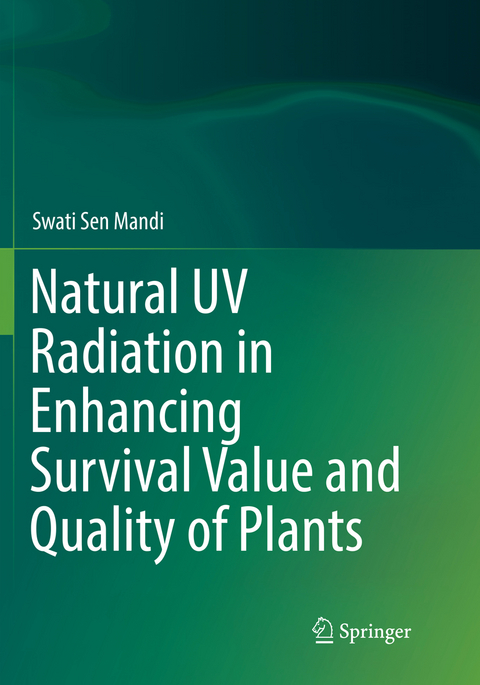
Natural UV Radiation in Enhancing Survival Value and Quality of Plants
Springer, India, Private Ltd (Verlag)
978-81-322-3830-0 (ISBN)
This
book is the first of its kind to highlight the positive impact of natural UV
radiation on plants through unique adaptations in various metabolic pathways, and
provides an evolutionary sketch of the development of molecular mechanisms for
protecting plants from solar UV ever since their migration to terrestrial
habitats. Experimental evidence is provided for establishing how plants, through
their stationary habit in the open field, survive and flourish by developing suitable
UV acclimation strategies through the repair of damaged macromolecules and/or
upregulation of screening compounds viz. flavonoids. Presenting an analysis of related
literature, it also highlights the importance of outdoor experiments over those
in closed chamber under artificial UV light for obtaining realistic data.
The book presents a comprehensive
account of the stratospheric ozone layer, its formation and seasonal thinning,
with particular reference to alarming anthropogenic destruction of the ozone
layer since the last quarter of the twentieth century, which has resulted in increased
UV fluence on Earth. It discusses variations in the hazardous impact of UV on
life at different latitudes through the ages, and examines altitudinal variations
in UV effects in case studies demonstrating high antioxidant content and aroma
status in Darjeeling tea leaves (at high altitudes) compared with those of the same
tea clones in Assam leaves (at low altitudes), with both sites being at the same
latitude. It provides evidence which suggests that the UV effects relating to
the expression of seed vigour-viability could be epigenetic.
Further, it presents recently developed microscopic
technologies for demonstrating the penetration of UV into plant cells, and discusses
how cellular metabolism can be affected either directly or via signal
transduction. Effect of damage in DNA (the key target of UV radiation) has been
demonstrated and estimated using precise techniques. The latest “FOX Hunting”
technique as a useful means of transcriptome analysis that may be used for
developing UV tolerant plants through Marker Assisted Breeding has also been
discussed. Using biochemical and biotechnological methods, the experiments
presented highlight the gene X environment based upregulation of specific
metabolic pathways, allowing i) value addition in plant-derived food, and ii) paving
the way for the industrial manufacture of Alternative Medicine products. The
book is enriched by a critical review of the available literature and
appropriate case studies selected from the author’s own findings, which span nearly
four decades of active research.
Prof Swati Sen Mandi, basically an experimental biologist specialized in plant molecular biology, since her PhD at Cambridge University, UK, has been devoting all her research career to understand how plant system responds to abiotic stresses of all kinds. From studies on cell molecular events on (rice) seeds stored under ambient storage in tropical regions and also on tea leaf quality at high / low altitude she has made commendable progress in the understanding on the positive aspects of UV radiation particularly with respect to DNA repair and formation of secondary metabolites towards developing acclimation strategy. She has presented experimental data to demonstrate higher accumulation of flavonoids related to antioxidant and aroma potential in plants at high altitudes viz. in Darjeeling tea (leaf). Her interest in addressing problems of societal relevance through research on medicinal plants collected from high / low altitude (growing under high / low UV fluence) has been usefulin her continuing efforts for setting up a Centre for Research on medicinal plants of Eastern and North Eastern India. Significantly besides her excellent publications in reputed scientific journals and her experience as visiting scientist in different internationally renowned laboratories together with the International (Kenya) patent right she earned for her UV radiation related work on tea and the National (India) patent right she earned for development of DNA marker assisted selection of rice varieties with high seed vigour and viability traits bear ample testimony to her scientific standing. Her findings in the recent years on plant cell molecular mechanisms that constitute acclimation strategy associated trait development in plants has been documented in this text book entitled “Natural UV radiation in enhancing survival value and quality of plants”.
1. Natural
Ultraviolet Radiation.- 2. Effect Of UV Radiation On Life Forms.- 3. UV Radiation Induced Damage at Molecular Level.-
4. Signal Transduction Transmitting UV Effect In Plant Cells.- 5. UV Induced
Acclimation Strategies In Plants.- 6. Genotype X (UV) Environment Interaction-based Trait Expression.- 7. Breeding/Transgenic Approach for Enhancing UV Adaptive Traits in Plants.
| Erscheinungsdatum | 27.08.2018 |
|---|---|
| Zusatzinfo | 40 Illustrations, color; 45 Illustrations, black and white; XIX, 204 p. 85 illus., 40 illus. in color. |
| Verlagsort | New Delhi |
| Sprache | englisch |
| Maße | 178 x 254 mm |
| Themenwelt | Naturwissenschaften ► Biologie ► Botanik |
| Naturwissenschaften ► Biologie ► Mikrobiologie / Immunologie | |
| Naturwissenschaften ► Biologie ► Ökologie / Naturschutz | |
| Naturwissenschaften ► Biologie ► Zellbiologie | |
| Naturwissenschaften ► Physik / Astronomie ► Angewandte Physik | |
| Schlagworte | flavonoids • Plant quality • Plant survival • signal transduction • UV tolerance |
| ISBN-10 | 81-322-3830-3 / 8132238303 |
| ISBN-13 | 978-81-322-3830-0 / 9788132238300 |
| Zustand | Neuware |
| Haben Sie eine Frage zum Produkt? |
aus dem Bereich


